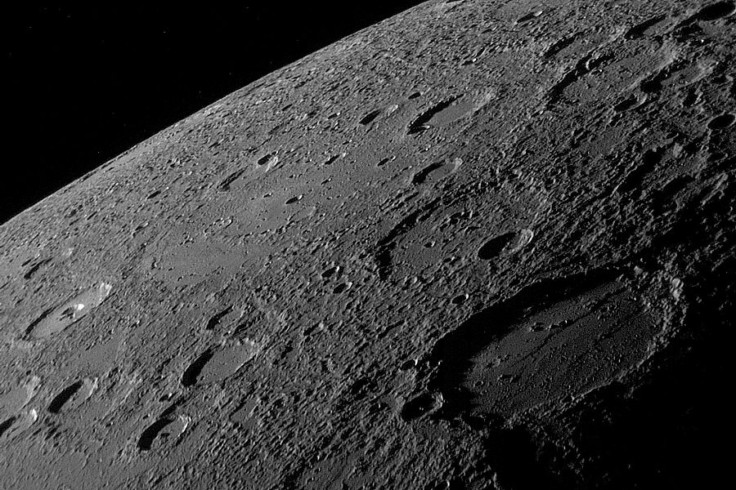NASA's MESSENGER To Orbit Mercury, Answer Big Questions

The first space probe in 40 years to approach the planet Mercury will begin orbiting the planet tonight. It will be the first spacecraft to orbit the planet and study it in depth.
The mission is called MESSENGER, for Mercury Surface, Space ENvironment, GEochemistry and Ranging. After more than six years of maneuvering between the Earth, Venus and Mercury itself, it will enter a 12-hour orbit, with the minimum altitude above the surface of 200 kilometers (124 miles). MESSENGER will start slowing down at 8:45 p.m. Eastern, firing its engines for a total of 15 minutes in order to slow and allow itself to be captured by Mercury's gravity.
When it goes into orbit, MESSENGER will be 155.06 million kilometers (96.35 million miles) from Earth, which means the radio signals sent by mission controllers will take more than 8 minutes to get to the probe.
Mercury is the closest planet to the sun, completing one of its revolutions in only 88 days. Surface temperatures on during the day can reach 426 degrees Celsius (798 degrees Fahrenheit) -- hot enough that lead and zinc melt. Nighttime temperatures plunge to -173 degrees C (-279 F), cold enough to liquefy neon gas. Mercury also spins very slowly, and does so in such a way that a single day on Mercury lasts 176 days -- two of the planet's years. On the surface, the sun would appear to travel from east to west, then jog east, and then start moving west again.
So far the only space probes to get a close look at Mercury are Mariner 10 in the mid-1970s, and MESSENGER itself as it has passed the planet on previous flybys.
MESSENGER will address several questions. One is why the planet is so dense. David Blewett, senior staff scientist at Johns Hopkins Applied Physics Lab, said it's an important question because Mercury could offer clues as to how the other planets formed as well.
Mariner established that the planet has a magnetic field, if much weaker than Earth's. That only opened up more questions, though. Most planetary scientists would say a magnetic field needs a molten or plastic core, along with the planet's own rotation. But there wasn't any evidence that Mercury's core was like that. The surface didn't look like it had been buckled or twisted which would have shown that there was a plastic layer under a crust.
Mercury also has a lot of iron, Blewett said. That's unusual. Evidence from the modeling is that all the smaller protoplanets would have had a fair amount of mixing, so people would have expected more normal iron to rock ratio, he said. Mercury seems to have an iron core that is much bigger relative to the planet than Earth's, some 42 percent of the planet's volume. Earth's core is 17 percent of the volume. That makes Mercury far denser, like a ball of iron surrounded by a thin layer of rock.
There are two major hypotheses. One is that the early sun went through a hotter and more active phase and evaporated the planet's outer layers, leaving what the core of a world that was once much larger. The second is that the outer layers got blown off in a massive impact.
The probe will also investigate what the exact structure of Mercury's core is, and a try to get a more exact picture of the planet's magnetic field than Mariner did. Those two pieces of information will reveal much about how the planet maintains its magnetic field.
MESSENGER will also get a much better visual picture of Mercury because Mariner was only able to see one side. That's because Mercury spins three times on its axis for every two orbits. Mariner happened to pass by when the same side of the planet was in daylight, so it only got pictures of half of the surface. Since MESSENGER will be orbiting Mercury for a year at least, it will get a much closer view and see the whole planet in much more detail. It also has a spectrometer, allowing it to see what the surface rocks are made of.
Because Mercury, unlike Earth, is not tilted relative to its orbital plane, there are areas near the poles where the sun would never clear the horizon. Those areas are a lot colder than the rest of the planet, and covered in a material that is as yet unidentified. Most scientists think it is water. These regions were discovered when ground-based astronomers bounced radio waves off the planet. MESSENGER has what is called a neutron spectrometer, which can detect hydrogen near the surface. If it turns out there are enhanced abundances of hydrogen in the shallow areas, that's a pretty good case for water ice, Blewett said.
To contact the reporter responsible for this story call (646) 461 6917 or email j.emspak@ibtimes.com.
© Copyright IBTimes 2025. All rights reserved.





















